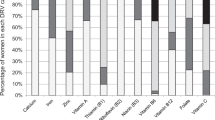Abstract
Objective:
To estimate the contribution of energy and selected nutrients from foods eaten as snacks and as meals.
Subjects and methods:
Forty-four nonpregnant women in the reproductive age, of whom 20 were lactating, participated in this study. Women from rural households were randomly selected and energy and nutrient intakes were estimated using 2 days' observed weighed food record. Snacks eaten between meals were estimated by weighed food record as well as recall, thrice per day.
Results:
The largest proportions (mean±s.e.) of fat (33±3.6%), vitamin C (36±4.1%) and a large proportion of vitamin A (30±4.4%) intakes were from snacks. Furthermore, snacks provided 20% of the energy intakes.
Conclusion:
Snacks are important for energy and nutrient intakes and adequacies in rural African women and have the potential to combat energy and nutrient deficiencies in low-income countries.
This is a preview of subscription content, access via your institution
Access options
Subscribe to this journal
Receive 12 print issues and online access
$259.00 per year
only $21.58 per issue
Buy this article
- Purchase on Springer Link
- Instant access to full article PDF
Prices may be subject to local taxes which are calculated during checkout


Similar content being viewed by others
References
Brouwer ID, Wijnhoven TMA, Burema J, Hoorweg JC (1996). Household fuel use and food consumption: relationship and seasonal effects in central Malawi. Ecol Food Nutr 35, 179–193.
Damton H, Hassan N, Karim R, Duthie MR (1988). Tables of Nutrient Composition of Bangladesh Foods. Hellen Keller International. Moni Printers & Packages Ltd.: Dhaka.
FAO/WHO (1994). Fats and Oils in Human Nutrition. Report of a joint expert consultation. FAO Food and Nutrition Paper 57 Food and Agricultural Organization of the United Nations: Rome.
FAO/WHO (2001). Human Vitamin and Mineral Requirements. Report of a joint FAO/WHO expert consultation. Food and Agricultural Organization of the United Nations: Rome.
FAO/WHO/UNU (1985). Energy and Protein Requirements Report of a Joint FAO/WHO/UNU Expert Consultation. World Health Organization Technical Report Series 724. World Health Organization of the United Nations: Geneva.
Ferguson EL, Gadowsky SL, Huddle J-M, Cullinan TR, Lehrfeld J, Gibson RS (1995). An interactive 24-h recall technique for assessing the adequacy of trace mineral intakes of rural Malawian women; its advantages and limitations. Eur J Clin Nutr 49, 564–578.
Ferguson EL, Gibson RS, Weaver SD, Heywood P, Heywood A, Yaman C (1989). The mineral content of commonly consumed Malawian and Papua New Guinean Foods. J Food Comp Anal 2, 260–272.
Huddle JM, Gibson RS, Cullinan TR (1998). Is zinc a limiting nutrient in diets of rural pregnant Malawian woman. Br J Nutr 79, 257–265.
Lauritsen J (2006). [online] FoodCalc, Foocdcal version 1.3. (public domain)http://www.ibt.ku.dk/jesper/foodCalc [accessed 6th July 2006].
Mazengo MC, Simell O, Lukmanji Z, Shirima R, Karvetti R-L (1997). Food consumption in rural and urban Tanzania. Acta Tropica 68, 131–326.
Møller A, Saxholt E (1996). The Composition of Foods – fourth edn. Levnedsmiddelstyrelsen. Gyldendals Forlagsekspedition: København.
Nordeide MB (1995). The Composition of Malawian Foods. Programme de Recherche SSE. CNRST/University of Oslo, Norway.
Nyambose J, Koski KG, Tucker KL (2002). High intra/interindividual variance ratios for energy and nutrient intakes of pregnant women in rural Malawi show that many days are required to estimate usual intake. J Nutr 132, 1313–1318.
West CE, Poortvliet EJ (1993). The Carotenoid Content of Foods with Special Reference to Developing Countries. US Agency for International Development-VITAL, Washington, DC.
West CE, Pepping F, Temalilwa CR (1988). The Composition of Foods Commonly Eaten in East Africa. Technical Centre for Agricultural and Rural Cooperation and Food and Nutrition Cooperation, Wageningen Agricultural University.
Acknowledgements
We thank the participants of the survey, Traditional Authority Timbiri and family, the staff at Department for Agricultural Research and Technical Services, Ministry of Agriculture and Lunyangwa Agricultural Research Station, Malawi. We also thank Dr Linley Chiwona-Karltun for inspiration and Dr Jonathan Mkumbira for establishing contacts for the fieldwork. A special thanks to the staff involved in data collection. We also thank Dr Jóhanna Haraldsdóttir and Dr Ole Hels for help during the preparation of the manuscript.
This study was sponsored by AN Industry Consult A/S, The Nordic Africa Institute and the Council for Development Research, Danish International Development Assistance (DANIDA), Ministry of Foreign Affairs, Denmark.
Author information
Authors and Affiliations
Corresponding author
Additional information
Guarantor: J Hallund.
Contributors: JH collected the data, analysed the data and wrote the paper. AH contributed to the study design, interpretation of results and preparation of the paper. IB contributed to collection of the data and interpretation of results. SHT contributed to the study design, interpretation of results and writing of the paper.
Rights and permissions
About this article
Cite this article
Hallund, J., Hatlöy, A., Benesi, I. et al. Snacks are important for fat and vitamin intakes among rural African women: a cross-sectional study from Malawi. Eur J Clin Nutr 62, 866–871 (2008). https://doi.org/10.1038/sj.ejcn.1602820
Received:
Revised:
Accepted:
Published:
Issue Date:
DOI: https://doi.org/10.1038/sj.ejcn.1602820



